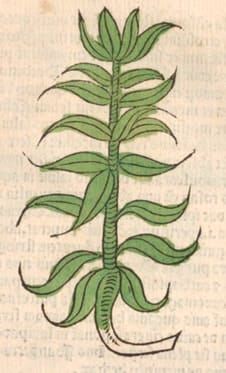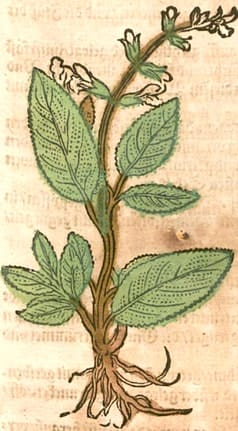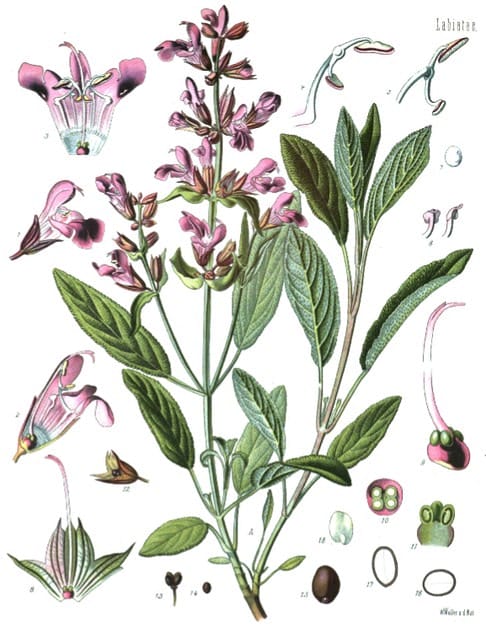Salvia, Sage

|

|
|
Herbarius latinus, Petri, 1485 |
Krauterbuch, Lonitzer, 1578 |
 Koehler’s Medizinal Pflanzen, 1887
Koehler’s Medizinal Pflanzen, 1887Botanical name:
Salvia officinalis
Parts used:
Leaf; Flowering tops
Temperature & Taste:
Neutral (Traditionally regarded as Warm; Cool by some), dry. Bitter, Pungent
Classifications:
2F. PURIFYING. 2O. ASTRINGENT. 2S. STRENGTHENING.
3C. ALEXIPHARMIC. 3D. CORDIALS & CARDIACS. 3G. EMMENAGOGUE. 3M. ARTHRITICS. 3P. MASTICATORIES & STERNUTATORIES
4a. CEPHALIC. 4c. CARDIAC. 4e. STOMACHIC. 4f. SPLENETIC. 4i. UTERINE. 4j. NERVINE. 4k. ARTHRITIC
TCM:
B. Clears Heat, Cools the Blood B. Clears Deficient Heat
Uses:
1. Benefits the Liver and Blood, Settles Wind, Benefits the Brain and Nerves:
-‘Good for the Liver, and to breed Blood’ (Culpeper)
-nourishes and strengthens the Liver and Blood, Uterus, Senses, Memory, Sinews, Nerves and Joints.
-Paralysis, Shaking or Trembling Limbs, Apoplexy, Convulsions, Epilepsy, Lethargy etc.
-quickens the Senses, restores the Memory; good for the aging Brain, helps with Alzheimer’s and Dementia
-clears and strengthen the Eyes, improves Eyesight
-long associated with Longevity; said to turn the hair black
-The tincture was said to strengthen all the inward parts, and the whole frame (Yin) of the body.
2. Move the Blood, Regulates Menstruation:
-menstrual irregularities associated with Deficiency, Heat, Qi stagnation or poor circulation (since Hippocrates)
-Amenorrhea, Scanty Menstruation with cramps, and PMS.
-promotes Fertility and prevent Miscarriage: it ‘maketh them Fruitful, it retaineth the Birth, and giveth it Life’ (Gerard).
–Agrippa said it ‘prevents Abortion, cleanses the Matrix, and makes Fruitful’.
–Difficult Labor and to clear a Dead Fetus.
-tonic during Pregnancy; prevents Miscarriage
-Trauma, Bruising
3. Clears Wind and Heat, Clears Phlegm, Resists Poison:
-Wind-Heat attacking the Head with excessive nasal discharge, Sinusitis
-beginning of Wind-Heat Colds and Flus and Fevers; Paracelsus used for Fever and acute diseases
-sore, inflamed or ulcerated Mouth and Throat.
-protects from the Plague and all Infectious Diseases.
-Mercurialism (Mercury poisoning)
-Coughing and Wheezing.
–Hildegard said it is good for ‘harmful humors’ and for those who ‘abound in excess Phlegm’.
4. Astringes, Benefits the Kidneys, Clears Deficient Heat:
-excessive Sexual desire (from Yin deficient Heat)
-Impotence or Frigidity associated with Kidney weakness.
-Diabetes and Diabetes-like disorders (a glass of Sage Wine after each meal).
-Menopausal symptoms, Flushing, Sweating, Restlessness
5. Astringes to Stop Sweating:
-Excessive Sweating, Night Sweats (including Menopause and Tuberculosis); the infusion is taken cold. (Commission E approved)
–profuse sweat, which occur in convalescence after acute diseases (Sydenham)
6. Stops Milk:
-Stops the flow of Milk in nursing mothers.
7. Clears Damp, Moves the Qi, Promotes Digestion:
-dampness of the digestion with poor digestion and appetite, intestinal gurgling etc.
8. Clears Heat and Damp, Promotes Urine:
-promotes Urine when cloudy or turbid as a result of Heat and Damp
-Damp-Heat type Edema.
9. Externally:
-as a wash and gargle for mouth problems such as inflamed Sore Throat, Ulcers of the Mouth and Throat, bleeding gums
–Thrush and Aptha of the Mouth (as a gargle)
-preserves the Teeth (Matthiolus)
-applied to skin conditions such as Eczema and Scrofula.
-said traditionally to cause the Hair to turn black
-the Oil is applied with alcohol to Alopecia.
-Ulcers and Wounds can also be treated externally with Sage.
-applied topically in ointments to Tumors
-washes, poultices and compresses are used for Cancerous Ulcers
-Sage Oil is used externally for Palsy, Apoplexy etc
Dose:
Infusion: 1–2 teaspoonful (3–6 grams)
Decoction: 3–6 grams added towards the end
Powder: 1–3 grams
Tincture (1:5): 30–60 drops
Juice: 1–3 oz.
Comment:
1. Hecker (Pract. Arzneimittell., 1814) said Sage was a tonic to the skin and mucus membranes and used it for the ‘restoration of suppressed dermal evacuation, as well as for the restriction of ample, debilitating sweat‘.
2. Osiander (Volksarzneymittel, 1829) relays the story of a chronic case of Hemoptysis who gradually became healthy with extended use of Sage.
Main Combinations:
Betony & Sage
Acute Diseases
1. Cold, Flu:
i. Sage with Elder flower, Thyme
ii. Sage with Camomile, Balm, Rosehip
iii. Cold, Flu, Sore Throat, Headache, Sage with Yarrow, Peppermint, Licorice
2. Cough:
i. Cough, Sage, Hyssop, Licorice (Herbarium Horstianum, 1630)
ii. For a ‘dangerous cough’, Sage with Rue and Cumin (The Physicians of Myddvai)
3. Cold in the Head, Sage seed toasted, Indian Spikenard, Ginger
4. Against Epidemic and Infectious Diseases, Sage with Rue, Long Pepper, Ginger, Nutmeg with Theriac
Wind Diseases
5. Wind of the Head; Headache, Migraine, Vertigo, Paralysis, Convulsions, Sage with Rosemary, Lavender, Marjoram, Cinnamon, Clove, Fennel seed, Mint, Hyssop, Balm, Ginger and Juniper berries (as in Cephalic Water of Mylius)
6. Paralysis:
i. Sage with Hyssop, Rosemary (as in Decoction for Paralysis)
ii. Sage with Cowslip, Lavender, Cress, Walnut (as in Compound for Paralysis of Salerno)
iii. Sage with Galangal, Aloeswood, Clove, Juniper berry, Cinnamon, Rosemary
7. Apoplexy:
i. Sage with Rosemary, Lavender, Juniper (as in Wine for Apoplexy)
ii. Sage with Juniper, Pennyroyal, Cress, Saffron (as in Tincture of Juniper Compound)
8. Vertigo, Dizziness:
i. Sage with Peony seed, Aniseed, Licorice (as in Decoction to Strengthen the Head)
ii. for Paralysis and Vertigo, Sage with Lavender, Hyssop, Mint, Clove, Nutmeg, Galangal, Calamus, Juniper berry, Peony seed (as in Powder for Paralysis and Vertigo of Nicholas)
9. Strengthen the Brain and Memory:
i. Sage with Rosemary, Betony, Balm, Licorice, Frankincense (as in Powder of Great Use Against Forgetfulness)
10. Insanity, Sage with Southernwood and Field Daisy, infused in wine. (Physicians of Myddvai)
11. Wind, Cold and Damp of the Head or Joints, Sage with Lavender, Marjoram, Thyme, Dodder, Betony, Nutmeg, Cinnamon, Cyperus, Calamus
12. Arthritis, Sage with Rosemary, Mistletoe, Sarsaparilla (as in Wine for Arthritis)
Sweating, Yin Deficiency
13. Excess Sweating:
i. Sage with Walnut shell and Horsetail (Kroeber)
ii. Sage and Hyssop (Meyer)
iii. Sage, with Hops, Nettle, Strawberry leaf, Walnut leaf
14. Night Sweats:
i. Sage with Walnut leaf, Wild Strawberry leaf and Nettle.
ii. Sage with Lady’s Mantle and Horsetail. (Treben)
15. Infertility from Damp, Sage decocted in Wine (Herbarium Horstianum, 1630)
16. Menopause:
i. with hot flashes, Sage with Feverfew and Yarrow
ii. Sage, Nettle, Comfrey, Nettle, Fennel, Licorice
17. Diabetes, combine Sage with Camomile as an infusion ‘Effective in many cases’. (Vitalogy)
Other
18. To strengthen the Stomach and promote digestion, Sage with Wormwood, Calamus and Mint
19. Hydrocephalus, Sage with Calamint, Pennyroyal, Savin and Camomile, boiled in sour wine and bathe the head
20. To stop Milk, Sage with Walnut leaf and Hops (Meyer)
Externally:
21. Shingles, Sage with Lady’s Mantle, Meliot, Oats, Oak bark, Camomile, decocted in water and used as a wash. (Treben)
22. Urticaria, Sage with Balm and Nettle
23. Mouth or Throat pain and inflammation, as a gargle Sage with Camomile and Horsetail (Fischer)
24. Tinnitus, as an oil Sage with Camomile, Meliot, Marjoram (as in Oil for Tinnitus)
25. Ointment for Bruising or Blood Stagnation, Sage with Rosemary, Lavender, Marjoram, Wormwood, St. Johns wort, Rue (as in Ointment for Congealed Blood)
26. Douche for vaginal discharge, leukorrhea Sage with Birch leaf, Plantain leaf, Oak bark
27. Gargle for Sore Throat:
i. Sage with Camomile
ii. Sage with Alum
iii. Sage with Oxymel
iv. Sage with Syrup of Mulberry
Major Formulas:
Decoction for Cough (Gabelhover)
Decoction to Strengthen the Head (Wirtzung)
Decoction to Warm the Head
Decoction for Paralysis (Praxis Medicinae)
Wine of Sage Compound
Tincture Against Convulsions
Four Thieves Vinegar
Compound for Paralysis (Salerno)
Powder for Paralysis and Vertigo (Nicholas)
Green Oil
1. Aromatic Powder:
i. Sage, Balm, Thyme, Peppermint, Hyssop, Lavender (equal parts). (Pharmacopoeia Austriaca, 1820)
ii. Sage, Hyssop, Horehound, Oregano, Rue, Savory, Scordium, Wild Thyme (equal parts). (Pharmacopoeia Austriaca, 1820)
iii. Sage, Balm,. Wormwood, Peppermint, Wild Thyme, Camomile (equal parts). (Pharmacopoeia Bavarica, 1822)
iv. Sage, Thyme, Wild Thyme, Hyssop, Water Mint, Wormwood, Oregano (equal parts). (Pharmacopoeia Gallica, 1818)
v. Sage, Rosemary, Mentha crispa (8 parts each), Orange peel (4 parts), Cinnamon, Ginger, Clove (2 parts each), Cubeb, Nutmeg (1 part each). (Pharmacopee Usuelle, Louvain, 1821)
2. Vulnerary Spirit:
i. Hyssop, Mentha Crispa, Sage, Rosemary (2 oz. each), flowers of Rosemary, Lavender (1 oz. each). Proof Spirit (10 pounds). Distil two-thirds. (Dispensarium Lippiacum, 1792)
ii. Sage, Wormwood, Peppermint, Rue, Rosemary, Lavender (4 oz. each), Alcohol (6 lbs.), Water (sufficient). After 24 hours, distil off 18 lbs. (Pharmacopoeia Oldenburgica, 1801)
iii. Wormwood, Dill, Sage, Tansy, Wild Thyme, Peppermint, Lavender (1 ½. oz. each), Spring Water (12 lbs.), Alcohol (8 lbs.). Infuse several days, distil 8 pounds. (Pharmacia rationalis, 1806)
iv. Wormwood, Rue, Sage (18 drams each), Fennel, Peppermint, Lavender 1 ½ oz. each), Spring Water (12 lbs.), Alcohol (8 lbs.). Infuse 2 days, distil 8 pounds. (Dispensarium electorale Hassiacum, 1806)
v. Lavender, Hyssop, balm, Mentha crispa, Oregano, Rosemary, Rue, Sage, Wild Thyme (1 oz. each), Alcohol 85% (10 oz.), Water (12 lbs.). Infuse 24 hours, distl 10 lbs. (Pharmacopoeia Austriaca, 1820)
vi. Fresh leaves of Sage, Angelica, Wormwood, Savory, Fennel, Mint, Hyssop, Balm, Sweet Basil, Rue, Thyme, Marjoram, Rosemary, Oregano, Calamint, Wild Thyme, Lavender (4 oz. each), Alcohol (128 oz.). Distil. (Pharmacopoeia Generalis, 1783)
vii. flowering herbs of Wormwood, Sweet Basil, Catmint, Hyssop, Majoram, Oregano, Rosemary, Rue, Sage, Thyme, Lavender (2 parts each), Proof Spirit (96 parts), Water (456 parts). Distil 194 parts. (Pharmacopee Usuelle, Louvain, 1821)
viii. Fresh herbs of Sage, Golden Rod, Mugwort, Birthwort (4 handfuls each), Agrimony, Ladies Mantle, Daisy, Chrysanthemum, Betony, Bugloss, Fennel, St. Johns wort, Plantain, Sanicle, Figwort, Vervain (2 handfuls each), Wine (40 lbs.). Digest until it begins to ferment, then slowly distil one-half. (Pharmacopoeia Wirtembergica, 1798)
3. Aqua Vulneraria Spirituosa, Spiritous Water for Wounds
A vulnerary for all types of Wounds and Trauma.
i. Fresh leaves of Sage, Rosemary, Savory, Oregano, Marjoram, Thyme, Wild Thyme, Hyssop, Balm, Calamint, Sweet Basil, Water Mint, Fennel, Angelica, Wormwood, Rue, Lavender, St. Johns wort (1 ounce each), Alcohol (2 pounds). Macerate 8 days, express, filter. (Pharmacopoeia Gallica, 1818)
ii. Fresh leaves of Sage, Angelica, Sweet Basil, Southernwood, Fennel, Hyssop, Marjoram, Balm, Water Mint, Oregano, Rue, Rosemary, Wild Thyme, Thyme, Lavender (1 part each), Proof Spirit (32 parts). Digest for 8 days, express and filter. (Pharmacopee Usuelle, Louvain, 1821)
Cautions:
Avoid large doses during Pregnancy.
Main Preparations used:
Distilled Water of the whole Herb, Distilled Oil, Salt of the Ashes, Conserve of the Flowers, Tincture of Sage
1. Sage Wine:
i. Fresh Sage leaf (1 ½ oz.), Red Wine (1 ½ lbs.). Macerate 24 hours, strain. (Pharmacopoeia Herbipolitania, 1796)
2. Distilled Water of Sage:
i. Sage in flower (1 part), Water (4 parts), distil 2 parts. (Pharmacopoeia Gallica, 1818)
-
Extra Info
- Research
